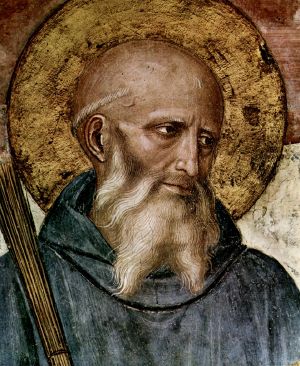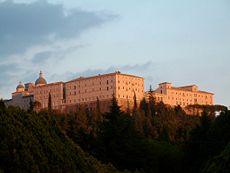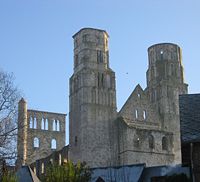Benedictine
A Benedictine is an adherent of the teachings of Saint Benedict of Nursia (c. 480-c. 547), who is renowned as the author of the Rule of St Benedict - the most important and influential set of monastic regulations in the western Christian world. Many monasteries observe the Rule of St Benedict, including Roman Catholic, Anglican and Orthodox groups, although the Benedictine monasteries within Roman Catholicism are the most numerous. In the sixth century C.E., St Benedict founded the "Order of Saint Benedict" (in Latin name: Ordo Sancti Benedicti, initials: OSB), sometimes called the "Black Monks" after the color of their habit (monastic dress); however, a Benedictine may technicaly be a monk, nun or oblate. Most monasteries of the Middle Ages belonged to the Benedictine Order.
Beyond its religious influences, the Rule of St Benedict has been one of the most important written works in the shaping of Western society, embodying, as it does, the idea of a written constitution, |authority limited by law and under the law, and the right of the ruled to review the legality of the actions of their rulers. It also incorporated a degree of democracy in a non-democratic society.
History
Antecedents and Early History

Christian monasticism first appeared in the Eastern part of the Roman Empire a few generations before Benedict, in the Egyptian desert. Following the ascetic example of Saint Anthony (251-356 C.E.), monks led by Saint Pachomius (286-346 C.E.) formed the first Christian monastic communities in the Egyptian desert. These communities were guided by what became known as an Abba (Aramaic for "Father," from which the term Abbot originates). Within a generation, both solitary and communal monasticism became very popular and spread outside of Egypt, first to Palestine and the Judean Desert and thence to Syria and North Africa. Saint Basil of Caesarea codified the precepts for these eastern monasteries in his Ascetic Rule, or Ascetica, which is still used today in the Eastern Orthodox Church.
Around the year 500 C.E., Saint Benedict chose the life of an ascetic monk living as a hermit in a cave near Subiaco, Italy. In time, he began to attract disciples. After considerable initial struggles with his first community at Subiaco, he eventually founded the monastery of Monte Cassino, where he wrote his Rule in about 530 C.E.
Founding of Monte Cassino

The first official Benedictine monastery was established by Saint Benedict of Nursia in Monte Cassino, Italy (ca 529). Most monasteries of the Middle Ages were of the Benedictine Order, even though it has been said that Benedict himself did not intend for his Rule to become the standard for Western Monasticism. However, it has also been argued that he made this inevitable because he provided so efficient an institution. In fact, the Benedictine Monasteries made such great contributions to religion, economics, education, and government that the years 550 to 1150 have been called the "Benedictine centuries."[1] The original purpose of the monasteries, though, was not to contribute to culture, but to ensure salvation for its members. Therefore, the Black Monks, as well as the Benedictine nuns had to take extremely strict religious vows of Stability (to remain in the monastery), of Conversation Morum, a Latin phrase still debated, and of Obedience (to the superior, because (s) he holds the place of Christ in their community). The abbots of the monasteries had absolute authority over the other monks; to assign them duties, punish them, and take charge of their comings and goings.
Saint Benedict's Rule was diffused with miraculous rapidity from the original Benedictine monastery at Monte Cassino through the whole of Western Europe, and every country witnessed the building of monasteries far exceeding anything that had yet been seen in spaciousness and splendor. Benedictine Abbeys quickly arose in all the great centers of population in England, France and Spain. The number of these monasteries founded between 520 - 700 C.E. is amazing. Before the Council of Constance, 1415 C.E., no fewer than 15,070 abbeys had been established of this order alone.
During the 1500 years of its existence, the Rule of St Benedict has become the leading guide in Western Christianity for monastic living in community.
However, with their growth in popularity, the Benedictine monasteries ironically acquired considerable material wealth, leading to some luxury and worldliness. The strictness of the rule was relaxed, until by the tenth century the decay of discipline was so complete in France that the monks are said to have been frequently unacquainted with the rule of Saint Benedict, and even ignorant that they were bound by any rule at all. Thus, during the more than 1500 years of their existence, the Benedictines were not been immune to periods of laxity and decline. In such times, dynamic Benedictines have often led reform movements to return to a stricter observance of both the letter and spirit of the Rule of St Benedict, at least as they understood it. Examples include the Camaldolese, the Cistercians, the Trappists (a reform of the Cistercians), and the Sylvestrines.
During the English Reformation, all Benedictine monasteries were dissolved and their lands confiscated by the throne. However, since the Oxford Movement there has been a revival of Benedictine monasticism in the Anglican Church and other Christian Churches.
Benedictine Confederation
The "Order of Saint Benedict" is fundamentally different from other Western religious orders: there is no legal entity called the "Order of St Benedict," run on similar lines with other Roman Catholic religious orders with their Generalates and Superiors General. Rather, the various autonomous Houses (that is, communities) have formed themselves loosely into Congregations (for example, Cassinese, English, Solesmes, Subiaco, Camaldolese, Sylvestrines) that in turn are represented in the Benedictine Confederation.
In the modern confederation of the Benedictine Order, all the Black Monks of Saint Benedict were united under the presidency of an Abbot Primate (Leo XIII, Summum semper, 12 July, 1893); but the unification, fraternal in its nature, brought no modification to the abbatial dignity, and the various congregations preserved their autonomy intact. The loose structure of the Benedictine Confederation is claimed to have made Pope Leo XIII exclaim that the Benedictines were ordo sine ordinis ("an order without order"). The powers of the Abbot Primate are specified, and his position defined, in a decree of the Sacred Congregation of Bishops and Regulars dated 16 September, 1893. The primacy is attached to the Abbey and International Benedictine College of Saint Anselm in Rome and the Primate, who takes precedence of all other abbots, is empowered to pronounce on all doubtful matters of discipline, to settle difficulties arising between monasteries, to hold a canonical visitation, if necessary, in any congregation of the order, and to exercise a general supervision for the regular observance of monastic discipline.
Rule of Saint Benedict
The spirit of Saint Benedict's Rule is summed up in the motto of the Benedictine Confederation: pax ("peace") and the traditional ora et labora ("pray and work"). Compared to other precepts, the Rule provides a moderate path between individual zeal and formulaic institutionalism; because of this middle ground it has been widely popular. Benedict's concerns were the needs of monks in a community environment: namely, to establish due order, to foster an understanding of the relational nature of human beings, and to provide a spiritual father to support and strengthen the individual's ascetic effort and the spiritual growth that is required for the fulfillment of the human vocation. The Rule of St Benedict has been used by Benedictines for fifteen centuries, and thus Saint Benedict is sometimes regarded as the founder of Western monasticism. There is, however, no evidence to suggest that Benedict intended to found a religious order. Not until the later Middle Ages is there mention of an "Order of St Benedict." His Rule is written as a guide for individual, autonomous communities; and to this day all Benedictine Houses (and the Congregations in which they have associated themselves) remain self-governing. Advantages seen in retaining this unique Benedictine emphasis on autonomy include cultivating models of tightly bonded communities and contemplative life-styles. Disadvantages are said to comprise geographical isolation from important projects in adjacent communities in the name of a literalist interpretation of autonomy. Other losses are said to include inefficiency and lack of mobility in the service of others, and insufficient appeal to potential members feeling called to such service.
Saint Benedict aimed with his Rule "to establish a school for the Lord's service" (cf. Prologue 45) where "we progress in this way of life [that, in his love, the Lord shows us] and in faith," and so "run along the way of God's commandments, our hearts overflowing with the inexpressible delight of love," in the hope that "never swerving from his instructions, but faithfully observing his teaching in the monastery until death, we shall through patience share in the passion of Christ that we may deserve also to share in his Kingdom" (cf. Prol. 21; 49-50).
Benedictine rule enjoined that, if possible, the monastery should contain within itself every necessary of life, as well as the buildings more intimately connected with the religious and social life of its monks. It should comprise a mill, a bakehouse, stables, and cow-houses, together with accommodation for carrying on all necessary mechanical arts within the walls, so as to obviate the necessity of the monks going outside its limits.
Benedictine monks (monastic men) and Benedictine nuns (monastic women) publicly profess the three Benedictine Vows of Stability (to remain in the monastery), of Conversion of Manners, and of Obedience in accordance with ch. 58.17 of the Rule of Saint Benedict of Nursia. According to the Code of Canon Law a Benedictine abbey is a "Religious Institute," and its professed members are therefore members of the "Consecrated Life," commonly referred to as "Religious." Benedictines who are not members of the Consecrated Life (i.e., Oblates) nevertheless endeavor to embrace the spirit of the Benedictine Vows in their own life in the world. Many Benedictine Houses have a number of Oblates (secular) who are affiliated with them in prayer, having made a formal private promise (usually renewed annually) to follow the Rule of Saint Benedict in their private life as closely as their individual circumstances and prior commitments permit.
Within the Order of Saint Benedict, other groups that use the Rule of Saint Benedict that are generally considered to be of the Benedictine tradition are the Cistercians, Bernardines, and Benedictine Sisters of Grace and Compassion, although these are not part of the Benedictine Confederation.
Saint Benedict's model for the monastic life was the family, with the abbot as father and all the monks as brothers. In Chapter 73 of his Rule, Saint Benedict commends the Rule of Saint Basil and alludes to further authorities. He was probably aware of the Rule written by (or attributed to) Pachomius; and his Rule also shows influence by the Rules of Saint Augustine and Saint John Cassian. Benedict's greatest debt, however, may be to the anonymous Rule of the Master, which he seems to have radically excised, expanded, revised and corrected in the light of his own considerable experience and insight.[1]
Saint Benedict's Rule organizes the monastic day into regular periods of communal and private prayer, sleep, spiritual reading, and manual labor – ut in omnibus glorificetur Deus, "that in all [things] God may be glorified" (cf. Rule ch. 57.9). In later centuries, intellectual work and teaching took the place of farming, crafts, or other forms of manual labor for many – if not most – Benedictines.
Traditionally, the daily life of the Benedictine revolved around the eight canonical hours. The monastic timetable or Horarium would begin at midnight with the service, or "office," of Matins (today also called the Office of Readings), followed by the morning office of Lauds at 3am. Before the advent of wax candles in the fourteenth century, this office was said in the dark or with minimal lighting; and monks were expected to memorize everything. These services could be very long, sometimes lasting till dawn, but usually consisted of a chant, three antiphons, three psalms, and three lessons, along with celebrations of any local saints' days. Afterwards the monks would retire for a few hours of sleep and then rise at 6 A.M. to wash and attend the office of Prime. They then gathered in Chapter to receive instructions for the day and to attend to any judicial business. Then came private Mass or spiritual reading or work until 9 A.M. when the office of Terce was said, and then High Mass. At noon came the office of Sext and the midday meal. After a brief period of communal recreation, the monk could retire to rest until the office of None at 3 P.M. This was followed by farming and housekeeping work until after twilight, the evening prayer of Vespers at 6 P.M., then the night prayer of Compline at 9 P.M., and off to blessed bed before beginning the cycle again. In modern times, this timetable is often changed to accommodate any apostolate outside the monastic enclosure (e.g., the running of a school or parish).
Inclusion of women
Priesthood was not initially an important part of Benedictine monasticism – monks used the services of their local priest. Because of this, almost all the Rule is applicable to communities of women under the authority of an abbess. The Prologue of Saint Benedict's Rule opens with the words: "Listen [carefully], o son" (Obsculta/Ausculta, o fili), an allusion to an important Old Testament wisdom tradition (e.g., Prov 1:8, 4:10, 19:20, 23:19). The exclusive use of the masculine form continues throughout the entire Rule. Nevertheless, from earliest days, well before some modern editions of the Rule came to render these opening words with "Listen, my child," communities of women have no less lovingly and obediently than their Benedictine brethren "inclined the ear of their hearts" and "welcomed and faithfully put into practice this advice from the father who loves them" (cf. Prol. 1). Indeed, throughout the centuries, communities of women following the Rule of St Benedict have flourished just as much as their Benedictine brethren, if not more so. For a while there were also "Double Monasteries" — adjoining communities of Benedictine monks and nuns under the authority of one joint superior, usually an abbess — they have not survived into modern times.
The Oblature
The word Oblate derives from the Latin oblatus, which means "one offered." Oblates of Saint Benedict offer themselves to God in much the same way that monks and nuns do, except that they do not take monastic vows or necessarily live within the monastic enclosure. Rather, they make a commitment to God, in the presence of the monastic community (or the parish community, depending on circumstances) to strive to live according to the Rule of St Benedict as adapted to suit their own life situations. Usually, the Rule is adapted according to the individual spiritual and practical needs of each oblate by the Abbot or Oblate-Master of the monastery to which he is to retain a bond of practical support and spiritual obedience.
Oblates may be male or female, celibate or married. They are not tonsured as monastics, and, unlike monastic vows, their oblation may be revoked at any time. Out of necessity, Antiochian oblates are not usually attached to a monastery, (except for those who are under the direction of Christminster), as there are currently no Benedictine monasteries in that jurisdiction. However, the oblature operates on the parish level.
Habit
Benedictine Monks were nicknamed "Black Monks" because of the color of their habits. The Holy Rule does not stipulate a particular color for the monastic habit, and the habit of unbleached, undyed, wool has not been unknown among Benedictines. However, the color most associated with the Benedictine tradition is black, (hence the name "black monk" used to refer to a Benedictine monk), and that is the color currently worn by Orthodox Benedictines.
The first layer of the habit is the tunic, which is secured in place by a belt. This is the form of habit worn by Oblates during their period of Novitiate. The next layer is the monastic scapular, which is a tabard-like garment worn over the tunic. The tunic, belt, and scapular, (with a head-veil for women), form the complete habit worn by Oblates while in the monastic enclosure and by monastics during the Novitiate. Outside of the monastery, the Oblate simply wears a reduced scapular and the Saint Benedict Medal under civilian clothing. When the monastic makes his solemn profession, he is tonsured and invested with the cowl.
Monastics and Oblates alike, upon their repose, are buried in the habit proper to their order.
Orthodox Order of Saint Benedict
Benedictine monks also exist in the Orthodox Church who strive to live according to the Holy Rule of St Benedict. While there is no actual incorporated body known as the "Order of Saint Benedict," Orthodox Benedictines enjoy good relations with each other, which frequently cross jurisdictional boundaries.
The Benedictine monastic tradition began with Saint Benedict of Nursia himself, who was a monk of the Orthodox Church in the 6th century. Influenced by the writings of Saint Basil the Great and Saint John Cassian, he composed a rule for the ordering of the life of monastic communities in the West, rather than adopting rules that had been composed for monks in a very different climate, with a different cultural and dietary background.
Most of the Benedictine communities existed in the West under what was geographically the canonical jurisdiction of the Patriarch of Rome. After some centuries of increasing distance between Rome and the other four ancient Patriarchates that formed the Pentarchy, (due to doctrinal, linguistic, and cultural differences, and the development of different schools of theology), the Patriarchate of Rome separated from the remainder of the Orthodox Church, taking with it most of the Benedictine communities that had come to flourish in the West since the time of Saint Benedict.
However, there were some Benedictines outside of the jurisdiction of Rome who remained Orthodox, not the least of whom were the monks of the Amalfion Monastery, which was a community of Benedictine monks from Italy who had come to reside on Mount Athos in the late tenth century, where they remained until near the end of the 13th century.
There are currently at least three Benedictine monastic houses within the Orthodox Church, namely, Our Lady of Mount Royal; the Monastery of Christ the Saviour; and the interesting case of the Saint Petroc Monastery, which, while not actually a Benedictine foundation, does have and welcome Benedictine monks, and runs a Benedictine Oblate programme. In addition, an Oblate programme exists at Saint Benedict Russian Orthodox Church in Oklahoma City, Oklahoma, USA [2]. All three of these houses and the parish in Oklahoma City are under the jurisdiction of the Russian Orthodox Church Outside Russia. Within the United States of America, the autocephalous Antiochian Orthodox Archdiocese of North America, while having no monastic houses, does have a number of parishes that run an Oblate programme.
The Benedictine tradition was largely lost to the Orthodox Church until the twentieth century, when a revival was seen, encouraged by the efforts to restore the Western rite to Orthodoxy.
There are currently no female Benedictine monastic houses in the Orthodox Church.
Notes
- ↑ "The era from the sixth to the twelfth centuries in Europe was christened "The Benedictine Centuries" by Cardinal Newman." See Daniel J. Boorstin, The Seekers: The Story of Man's Continuing Quest to Understand His World. (Vintage; Vintage Books Ed edition, 1999), 93.
ReferencesISBN links support NWE through referral fees
- Barry, Patrick, O.S.B. St. Benedict’s Rule: A New Translation for Today. Hidden Spring, 2004. Features inclusive, contemporary language and a streamlined text.
- Boorstin, Daniel J. The Seekers: The Story of Man's Continuing Quest to Understand His World. Vintage Books Ed edition, 1999. ISBN 978-0375704758
- Doyle, Leonard J., trans. The Rule of St. Benedict. Collegeville, MN.: The Liturgical Press, 2001. Retains the masculine gender of the original, one of the most widely used English translations of the Rule. Appearing in 1948, has remained in print ever since.
- Eberle, Luke and Charles Philippi, trans. The Rule of the Master. Kalamazoo, MI: Cistercian Publications, 1977. First English translation of the Italian RM.
- Fry, Timothy, O.S.B., ed. RB1980: The Rule of St. Benedict in English: In Latin and English with Notes. Collegeville, MN: The Liturgical Press, 1981. Often referred to by the shorthand “RB80” or “RB1980,” the standard masculine version.
- Heffernan, Thomas J. “Christian Biography: Foundation to Maturity.” In Historiography in the Middle Ages, 115-154. Ed. Deborah Mauskopf Deliyannis. Boston: Brill, 2003. Very readable scholarly article on Gregory’s historical milieu.
- Marmion, Dom Columba. Christ the Ideal of the Monk – Spiritual Conferences on the Monastic and Religious Life. (Engl. edition London 1926, translated from the French by a nun of Tyburn Convent)
- McCann, Justin, O.S.B. Saint Benedict. London: Sheed and Ward, Ltd., 1979. A life of this saint, written by a twentieth-century monk and Oxford-educated classics teacher.
- Mork, Wulstan, O.S.B. The Benedictine Way. Petersham: St. Bede’s Publications, 1987. Good background information on the Benedictines.
- O’Donovan, Patrick. Benedict of Nursia. New York: HarperCollins Publishers, 1984. Enjoyable life of St. Benedict.
- Schuster, Ildephonso. Saint Benedict and His Times. Gregory J. Roettger, trans. London: B. Herder, 1951. Helps re-create Benedict’s cultural and historical milieu.
- Southern, by Richard W. Western Society and the Church in the Middle Ages. Pelican, 1970.
- Srubas, Rachel. Oblation: Meditations on St. Benedict's Rule. Brewster, MA: Paraclete Press, 2006. One of the most beautiful books of lyrical poetry ever written, Srubas makes the Rule's eternal truths vibrate in the twenty-first century.
- Swan, Laura. The Benedictine Tradition. Spirituality in History Series. Collegeville, MN: The Liturgical Press, 2007. An anthology of famous and not-so-famous Benedictines.
- de Waal, Esther. A Life-Giving Way: A Commentary on the Rule of St. Benedict. Collegeville, MN: Liturgical Press, 1981. By a down-to-earth scholar living in a small cottage on the Welsh/English border (also a former history lecturer at Cambridge University, and a Celtic Christianity expert). A classic.
This article incorporates text from the public-domain Catholic Encyclopedia of 1913.
External links
All links retrieved January 20, 2022.
- An Introduction to the Rule by Jerome Theisen, former Abbot Primate of the Benedictine Confederation
- Orthodox Benedictines
- The Order of Saint Benedict - Official website of the order as it exists in the Catholic church
- Catholic Encyclopedia entry for The Benedictine Order
Credits
New World Encyclopedia writers and editors rewrote and completed the Wikipedia article in accordance with New World Encyclopedia standards. This article abides by terms of the Creative Commons CC-by-sa 3.0 License (CC-by-sa), which may be used and disseminated with proper attribution. Credit is due under the terms of this license that can reference both the New World Encyclopedia contributors and the selfless volunteer contributors of the Wikimedia Foundation. To cite this article click here for a list of acceptable citing formats.The history of earlier contributions by wikipedians is accessible to researchers here:
- Benedictine history
- Order_of_Saint_Benedict history
- Rule_of_St_Benedict history
- Order_of_Saint_Benedict_(Orthodox) history
- Primate_(religion) history
- Abbey history
The history of this article since it was imported to New World Encyclopedia:
Note: Some restrictions may apply to use of individual images which are separately licensed.

